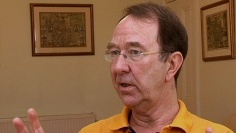LAURENCE REES: What do you think was the single greatest turning point of the war?
SIR IAN KERSHAW: Well, an obvious candidate for that would be the double defeat the Germans suffered in the end of ’42, beginning of ’43 in North Africa at Alamein and in Stalingrad. But I would actually go for December 1941. In December 1941 the Germans encounter their first major setback with the onset of the Soviet counteroffensive in front of Moscow. The first major setback which means that war is going to be prolonged indefinitely, the advance of the Germans had stopped and so that’s a crucial moment.
At the same time, well, two days later, the Japanese attack Pearl Harbour and immediately the Americans come into the war against Japan. And four days later on the 11th of December 1941 Hitler takes Germany into war against the USA – a war he has no idea how they can win. So within a few days then, you’ve got the German attack on the Soviet Union stopped and the war going into the indefinite future in the Soviet Union when only a blitzkrieg war had been planned for, and you’ve got the Japanese in the war, and you’ve got the Americans in the war, and you’ve got the Germans now fighting against the USA. I think that was the beginning of the end.
Of course the war had still a long way to go and so on, and the Germans did actually recover to some extent in ’42, but if you actually look for one point which is the turning point I think that was it. Hitler himself, and one or two comments he made around then, even seems obliquely to have recognised that as a really crucial juncture in the war now, that turning point.
LAURENCE REES: And, of course, that month is also crucial in the development of the 'Final Solution'. That’s the month when Hitler is pushing for an even more radical way forward?
SIR IAN KERSHAW: Yes, I mean after the Japanese attack on Pearl Harbour then Hitler goes to Berlin and has meetings with a number of his leaders, and on the 11th then speaks in front of the Reichstag and declares war on the USA, and on the 12th of December, the day after that, then he holds this speech to about 40 or 50 Nazi Party leaders in Berlin where he repeats again his prophecy of 1939 – a prophecy, incidentally, of which he always, although he has an excellent memory, Hitler, he always mis-dates to the 1st of September 1939, the date of the outbreak of the German war.
And so he repeats his prophecy and his minions go away from that meeting knowing now, it’s not a decision as such, but they go away knowing that the hour has come for a 'Final Solution'. Hans Frank goes back to Krakow and repeats that again to his own minions then in Poland, and there’s now talk about how to annihilate the Jews and so on. And so December ’41, as you say, is actually a pivotal moment there too I think in the escalation of the genocidal moves which were already underway before then, but now get a real push in the wake of the German declaration of the war on the USA.
Single turning point of the war
Professor Sir Ian Kershaw

- Why the war started
- Hitler’s expansionist aims
- Hitler and the origins of the war
- Hitler’s aggressive intentions
- Dunkirk
- Invading the Soviet Union
- Hitler's war in the East
- Hitler and the Holocaust
- Why the Nazis didn’t surrender
- Hitler in April 1945
- Single turning point of the war
- Single biggest mistake of the war
- Was Hitler mad
- Best leader of WW2
- Why study WW2
- Why study history
 Twitter
Twitter




